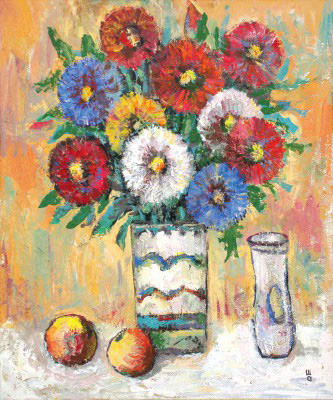Life motivations of Oleksa Shatkivsky
Image of a humble artist from a monastery town Ukraine remembers
Whenever I go to visit an old friend of mine Lviv collector Volodymyr Husar, I cannot take my eyes off several still life paintings on the wall of the living room that serves as a gallery. These are the paintings of a talented, but little-known to wide public artist Oleksa Shatkivsky (1908-79).
Oleksa Shatkivsky was born on May 28, 1908 in Pochaiv. Solemnly lyrical beauty of the monastery town, reflected in watercolors of young Taras Shevchenko, probably, affected the sensitive nature and the first art lessons were the painting classes conducted by local school teacher O. Tsikutsky.
After school studies, the fate led the young 18-yaer-old man to Pochaiv Iconographic School. A reward for diligent studies was an opportunity to spend hours at the Assumption Cathedral contemplating the works of Constantine Villyani – Italian artist, who worked in Volhynia in the 18th century, as well as the paintings of the famous Lviv artist Luka Dolynsky, awarded for his achievements by Empress Maria Theresa with a precious ring made in the early 19th century. Later, when artistic talent in a young man became obvious, he was sent to Warsaw, where he successfully passed the entrance exams in October of 1931 and became an auditor of Art Department at the Academy of Fine Arts.
It should be noted right away that while in the early 20th century the leading role in the training of young artists, immigrants from Galicia belonged to Krakow, in 1930 a significant number of young people were studying in Warsaw. Warsaw Academy of Fine Arts at that time provided fine professional training based on a solid image, thoughtful color scheme, and developed compositional thinking. Shatkivsky’s teachers were the leading artists of the time: Wladyslaw Skoczylas, who taught drawing, Tadeusz Pruszkowski, who taught painting, and Leon Jan Wyczolkowski – graphic art.
While still a student Shatkivsky presented his graphic works at exhibitions of Ukrainian Art Association “Spokii” (Peace) in Warsaw and at the Institute for Art Propaganda in Lviv, Rivne, Lutsk: sheets Drovoruby (Woodcutters), Shvachka (Seamstress), Babusia (Grandmother), Selianyn iz Pochaiva (Peasant from Pochaiv).
After completing his studies with a graduation painting Sharvarok in June of 1939 the young artist received a diploma of the Warsaw Academy and returned to his native Pochaiv to work as a teacher of drawing. Then it was the time of the “first Soviets,” deportations of rich peasants, mass repressions of young people, and, eventually, the war… But the artist did not stop painting he loved so much and in April of 1942 he participated in an exhibition of the Union of Ukrainian Fine Artists in Warsaw.
When the war was over in 1946 he moved to Lviv. He worked there as a teacher at the School of Applied Art, from 1948 he taught a course in graphic art at Lviv State Institute of Applied and Decorative Art (LSIADA), and from 1950 he taught painting at the Ukrainian Polygraphic Institute. But a serious illness forced the artist to quit teaching job. However, he did not stop painting…
Shatkivsky’s landscapes reveal the masterly style of the colorist artist based on his ability to harmoniously combine basic and complementary colors, elegant juxtaposition of warm and cold colors, sense of color dominant in the composition of some landscape. Color palette of gold and scarlet, green and yellow, cornflower blue and silver gray not only creates harmony, but also gives the painting an appropriate emotional and psychological state and psychological meaning: Pasika (Beegarden), 1954; Doroha v Karpatakh (The Road in the Carpathians), 1961; Khaty Zymoiu (Houses in Winter), 1965; Khata de Narodyvsia Oleksa Shatkivsky (House where Oleksa Shatkivsky was Born), 1968; Volynsky Peizazh (Volyn Landscape), 1971; Zymovy Kraievyd (Winter View), 1974.
The artist’s favorite genre was well-described by art critic Oleh Sydor, who wrote that in Shatkivsky’s still lifes we can see his love for nature, sense of the surrounding and its philosophical reflection. Paintings Kvity v Syniomu Dzbanku (Flowers in a Blue Barrel), 1963, Natiurmort z Hrushamy (Still Life with Pears), 1964, Natiurmort z Yablukamy (Still Life with Apples), 1965, Aistry (Asters), 1966, Kaly (Calla Lilies), 1967, and Osinni Kvity (Fall Flowers), 1968 are filled with peaceful harmony and warmth. Life accuracy and timid nature are achieved by the artist through merely artistic techniques. Combined with folk basis of world’s perception and admiration of classical models, they enabled Shatkivsky to create his own individual manner, marked by tenderness and purity of style, and the exceptional simplicity and straightforwardness are not inconsistent with subtle expression, integrity and poetry of his works. Structurally strong and plastic form of apples and pears, plates and fabrics modeled with color (similar to Paul Cezanne’s paintings) make the flowers permeated with air and vibrating background more prominent. Broad strokes of thick paint form dishes and fruit, often outlined with black color, which disciplines the volume and color, while the flowers and the surrounding elements are painted with smaller strokes and it brings a feeling of such depth and fresh lightness that attracts the audience to Shatkivsky’s paintings: Kvity Bilia Vikna (Flowers by the Window), 1975; Kvity v Posudi (Flowers in a Bowl), 1975; Kvity (Flowers), 1976. The desired effect is reinforced by the nature of painting textures, enriched with different techniques: blending paint on a canvas surface – with a brush, palette knife, fingers, and scraping the paint layer in certain parts. Tempera technique also contributes to this effect. The artist used this technique in the latest period of his artistic career and we can see it in the paintings Mamyni Kvity (Mom’s Flowers), 1977; Lilei ta Kvity (Lilies and Flowers), 1978; Kvity v Hlechyku (Flowers in a Pot), 1978-79.
Artistic career of Oleksa Shatkivsky lasted for half a century. Honest. Decent. Kind.






